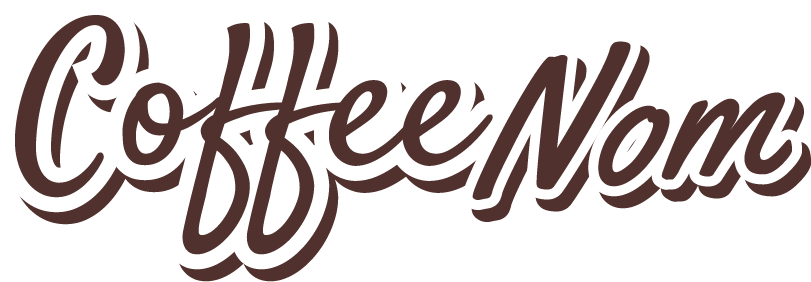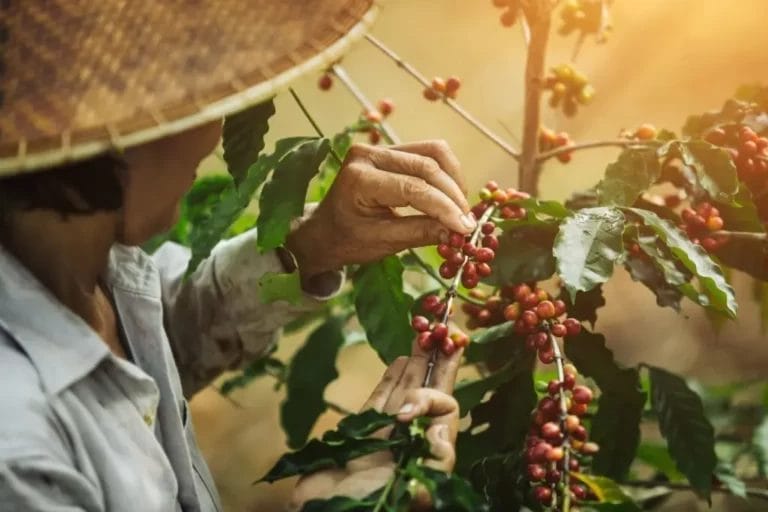Vietnamese coffee, or cà phê sữa đá, may look or feel like just another variation of a milk-based coffee when you take a quick look at it.

So what really is “Vietnamese coffee”? And what really makes it unique? Let’s get to answering all your questions. But first, it’s time to get into your favorite storytime, the history of Vietnamese coffee.
A Quick History Of Vietnamese Coffee
Coffee was introduced to Vietnam back in the 18th century by Dutch and French colonial settlers who brought coffee plants into the country. Along with coffee, the settlers brought along an ingredient that has continued to be a staple of the industry ever since: sweetened condensed milk.
But they didn’t bring this along to get the Vietnamese hooked on sweet goodness. Vietnam’s culture back then wasn’t exactly milk-dependent, so the new settlers struggled to get a steady supply of milk for their coffee.

The settlers took notice of the landscape of the country. The mountain areas, the micro-climates with endless coffee cultivation possibilities, motivated the French to start the coffee industry in Vietnam.
Even after the colonial administration went away, the coffee industry continued to thrive in Vietnam. Eventually, Vietnam became one of the highest coffee-producing countries.
What Makes Vietnamese Coffee Unique?
So you wanna know how to make Vietnamese coffee. To do so, you’ll need to ensure you get the following.
The Phin (Vietnamese Coffee Maker)
The Phin is a traditional Vietnamese brewing device. It’s highly cost-effective and a low-tech device that combines a drip filter and a coffee press. In simple terms, it’s just a coffee press that you place on top of your mug.
Though processing with the Phin is really slow since it’s drip coffee and can only brew one cup at a time. But the experience is something worth remembering.
Robusta Beans
Another aspect that makes Vietnamese coffee unique (and very strong) is the Robusta bean used for the brew. Robusta beans are high in caffeine and produce a more bitter taste. The bitterness of the flavor compliments the sweetness of the milk added to the ground coffee.
Sweetened Condensed Milk
The secret of the flavor present in Vietnamese coffee is the sweetened condensed milk. Arabica beans can give you a naturally sweet coffee, and adding condensed milk to it can only make you feel like you’re downing concentrated syrup.
But when you add the milk to a cup of coffee made out of Robusta beans, the contrast of high-caffeine bitterness and sugary sweetness creates a full body with a fantastic mouthfeel, and the coffee feels rich.
Ingredients For Vietnamese Coffee
- Sweetened condensed milk (2 tablespoons)
- Medium-coarse ground robusta beans (2 tablespoons)
- Hot water (1 cup)
- Ice cubes (1 cup)
- Phin coffee dripper
- 2 heatproof glasses
- Ice cubes (optional)
Brewing Vietnamese Coffee In Easy Steps
Now that all the ingredients are set, let’s get brewing!
Step #1: Heat Your Water
The ideal temperature for the coffee is 195-205°F. If you don’t have a thermometer at hand, letting the water sit for at least 30 seconds can get the job done.
If you use boiling water, your coffee will taste burnt and horrible.
Step #2: Add Condensed Milk In The Glass
Take one of the glasses, and put 2 tablespoons of condensed milk in the glass. Of course, you can add more or less, but that entirely depends on your personal preference.
Step #3: Add In The Coffee
It’s time to add the coffee to your Phin. If you’re struggling to maintain consistency, you can aim for the same grind you’d try out in a French press.
Step #4: Add The Filter In
Now it’s time to add in the metal coffee filter of the Phin. Push the filter down, and give it a little twist.
Note that the amount of pressure you apply will affect the final taste, so push carefully.
Step #5: Place The Phin On Top Of A Glass
Now that the Phin is ready, put it on top of the condensed milk glass, and collect the hot water you boiled earlier.
Step #6: Fill The Phin With Water
Once the Phin is set, fill up the Phin with hot water, and place the lid on top. Your coffee should take 3-5 minutes to drip into the glass.
Step #7: Stir The Mix
Once all the coffee has been extracted, you’ll notice that your glass has 2 layers. Coffee on top, condensed milk at the bottom. Take the spoon and stir to mix the condensed milk and the coffee.
If you’re planning to enjoy a cup of hot coffee, you can stop at this step. If not, continue.
Step #8: Take The Second Glass And Fill It With Ice
Take a second glass, and fill it with a cup of ice cube.
Step #9: Pour Coffee Mix Over The Ice
When you’re done, pour the freshly brewed coffee over the ice.
Step #10: Let The Coffee Cool Down And Enjoy
You can either stir the coffee with ice, so all the liquid cools down faster, or let the coffee sit on ice for around a minute. After that, your coffee is ready for drinking!
Having fun Nomies? Check out our piece on everything about turkish coffee.
The Difference Between Vietnamese And Drip Coffee
Many compare Vietnamese coffee to drip filter coffee since the brewing method is basically the same: you put coffee grounds and hot water in the maker and let gravity do its job. But there’s a lot more to it than that.

Difference #1: Beans
Most regular coffee drinks that you see on the market are of the Arabica type. Though many manufacturers blend in some Robusta for the added flavor variety, Arabica beans are the primary go-to for any avid coffee drinker.
A significant proportion of Vietnam’s produce is Robusta beans. But they don’t get all the attention since a majority of the Robusta gets blended with Arabica, and they get all the popularity.
However, Robusta reigns in the local coffee market and coffee shops in Vietnam. Since Vietnamese coffee revolves around Robusta, that’s where the uniqueness comes from.
Difference #2: Brewing Method
Though both Vietnamese and regular drip coffee is brewed with a drip method, the difference is still visible.
Regular drip coffee makers use a paper filter, whereas the Phin uses a metal mesh filter. You may think of it as nothing major, but the final taste of these two coffees will tell you the difference.
Paper filters leave a trace of their taste in the coffee unless you pre-rinse it, and the filter is of high quality. Also, with a paper filter, you can keep more coffee grounds out of your cup, which makes for a cleaner cup.
Metal mesh filters are reusable and don’t leave any aftertaste in the coffee cup. However, they allow more coffee grounds to pass through, making the coffee richer.
Difference #3: Brew Time
The difference in brew time for both these brewers comes from the difference in brewing method and the grind size.
Paper filters allow the water to pass through relatively faster than a traditional Phin. The brew time may only have a minute difference between them, but it’ll still yield more coffee than coffee made by a Phin.
Since Vietnamese coffee takes more time for the water to pass through, the coffee comes out as more concentrated.
Vietnamese coffee may seem time-consuming, but the higher brew time is necessary to ensure that all the grounds have been fully extracted.
Difference #4: Flavor
It’s a fact that every coffee tastes different, but even then, Vietnamese coffee brings something unique to the coffee table.
The dark roasted beans give Vietnamese coffee a heavy body with low acidity. The bold taste encourages the use of condensed milk and ice in the recipe.
As we mentioned earlier, Vietnamese coffee is highly concentrated, making it a strong coffee. So strong, in fact, that it surpasses Espresso. But more on that later.
Difference #5: Grind
Vietnamese coffee requires a coarser grind since the metal mesh filter can’t prevent finer grinds from slipping in the cup. Also, you’ll need a longer brewing time if you want a complete extraction since coarse grounds have a lower surface area.
In the case of a drip coffee maker, you can use finer grinds since the hole in the filter is much smaller, and paper filters hold back most of the fine coffee grounds. And since thinner grounds have a higher surface area, the extraction process is faster.
Difference #6: Roast
French roast is the recommended roast for Vietnamese coffee, which is a very dark roast. A darker roast takes away the extra acidity. But for Robusta beans, this is actually a good thing.
Since Robusta doesn’t have a naturally good taste like Arabica, dark roast helps Robusta offer the flavor that many can miss out on.
Difference #7: Serving
It’s not just the differences in brewing; the serving of Vietnamese coffee sets it apart visually from the drip coffee as well.
Drip coffee is best served in a ceramic cup or mug. Vietnamese coffee is served in a tall glass, where the layers of the coffee are visible.
Another noticeable difference comes from the addition of milk and ice. Though you can enjoy Vietnamese coffee all hot, it’s traditionally served with ice, milk, and sugar.
Why Vietnamese Coffee Is So Strong
Robusta is a bean category that is already high in caffeine. So when you’re using Robusta beans, your cup of coffee is bound to come out strong from the high caffeine levels and intense taste.
Though Vietnamese coffee is never served without milk or additives that counter the bitterness, it’s still considered a strong coffee drink. So much so it can rival Espresso in terms of concentration, taste, and caffeine count.

How Strong Is Vietnamese Coffee Compared To Espresso?
Espresso has 64 mg of caffeine per 8oz of serving. If you take an 8oz cup of Vietnamese coffee, it has 265 milligrams of caffeine.
Basically, 1 shot of Vietnamese coffee=4 shots of Espresso. That’s enough caffeine to get you through the day and then some.
Had fun reading? You’ll love to read our piece on what is americano coffee.
Bottom Line
Vietnamese coffee is a lovely peek into Vietnamese coffee culture. It’s brilliant how their traditional drink is iced milk coffee since their weather is tropical and hotter than many of us are used to.
Planning to try out Vietnamese iced coffee? Are you making it at home or ordering it at a local coffee shop? Enjoy your cup!
Cheers!
FAQs
Vietnam’s coffee production is mainly Robusta coffee beans. So Robusta has been the main content of Vietnamese coffee. But since Vietnam has started producing Arabica bean, it’s not all Robusta.
Dark roasting Robusta beans give them a chocolaty flavor profile. Since the coffee is highly concentrated, the final coffee contains the chocolate flavor coming from the beans.
The right water temperature for Vietnamese coffee is around 195-205°F.
Vietnamese coffee is more concentrated than Espresso, so it’s a stronger coffee than Espresso. Plus, Vietnamese coffee has an extended flavor profile from the added milk and sugar compared to Espresso, which is just concentrated black coffee.
The use of condensed milk is a traditional practice. When coffee first originated in Vietnam, they didn’t have a fresh milk supply, so the French settlers had no choice but to use condensed milk in their coffee. The recipe stayed the same over the ages, and Vietnamese coffee still uses sweetened condensed milk.

